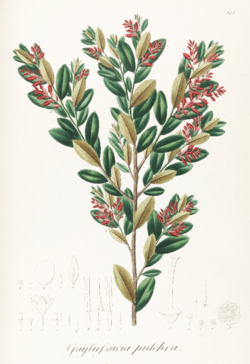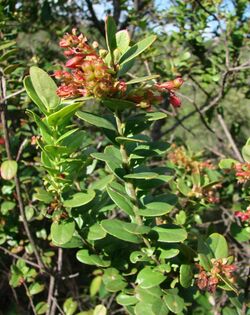Biology:Gaylussacia
| Gaylussacia | |
|---|---|

| |
| Gaylussacia pulchra[1] | |
| Scientific classification | |
| Kingdom: | Plantae |
| Clade: | Tracheophytes |
| Clade: | Angiosperms |
| Clade: | Eudicots |
| Clade: | Asterids |
| Order: | Ericales |
| Family: | Ericaceae |
| Subfamily: | Vaccinioideae |
| Tribe: | Vaccinieae |
| Genus: | Gaylussacia Kunth |
| Type species | |
| Gaylussacia buxifolia Kunth
| |
Gaylussacia is a genus of about fifty species of flowering plants in the family Ericaceae, native to the Americas, where they occur in eastern North America and in South America in the Andes and the mountains of southeastern Brazil (the majority of the known species). Common English names include huckleberry (shared with plants in several other genera) and "dangleberry".
Gaylussacia plants are often a component of an oak-heath forest.[2][3] They are deciduous or evergreen shrubs growing to a height of 0.4–1.8 metres (1 ft 4 in–5 ft 11 in).
Ecology
Gaylussacia species are used as food plants by the larvae of some Lepidoptera (butterflies and moths) species including Coleophora gaylussaciella (which feeds exclusively on Gaylussacia) and Coleophora multicristatella.
Classification
Gaylussacia is named in honor of the French chemist Joseph Louis Gay-Lussac (1778–1850). It is closely related to Vaccinium,[4] and it is still unclear whether the commonly understood line between Vaccinium and Gaylussacia is justified.[5] A 2002 paper found that molecular data did not support past divisions of Gaylussacia into sections.[4]
Fossil record
Pliocene seed and fruit fossils of †Gaylussacia rhenana are described from sand-filled river-channels in the brown coal pit of Fortuna-Garsdorf near Bergheim, North Rhine-Westphalia in Germany .[6]
Species
References
- ↑ 1827 illustration from Plantarum Brasiliae icones et descriptiones hactenus ineditae. Vol. 1. Author: Johann Baptist Emanuel Pohl
- ↑ The Natural Communities of Virginia Classification of Ecological Community Groups (Version 2.3), Virginia Department of Conservation and Recreation, 2010
- ↑ Schafale, M. P. & A. S. Weakley (1990). "Classification of the natural communities of North Carolina" (PDF). North Carolina Natural Heritage Program, North Carolina Division of Parks and Recreation. http://www.ncnhp.org/Images/Other%20Publications/class.pdf.
- ↑ 4.0 4.1 Floyd, Jennifer Whitehead (2002). "Phylogenetic and biogeographic patterns in Gaylussacia (Ericaceae) based on morphological, nuclear DNA, and chloroplast DNA variation". Systematic Botany 27 (1): 99–115. doi:10.1043/0363-6445-27.1.99.
- ↑ Kathleen A. Kron, E. Ann Powell and J. L. Luteyn (2002). "Phylogenetic relationships within the blueberry tribe (Vaccinieae, Ericaceae) based on sequence data from matK and nuclear ribosomal ITS regions, with comments on the placement of Satyria". American Journal of Botany 89 (2): 327–336. doi:10.3732/ajb.89.2.327. PMID 21669741.
- ↑ Review of Palaeobotany and Palynology Volume 26, Issues 1–4, September 1978, Pages 173-211, The pliocene flora of Fortuna-Garsdorf I. fruits and seeds of angiosperms by J. Van Der Burgh https://doi.org/10.1016/0034-6667(78)90011-8
External links
Wikidata ☰ Q2704451 entry
 |


